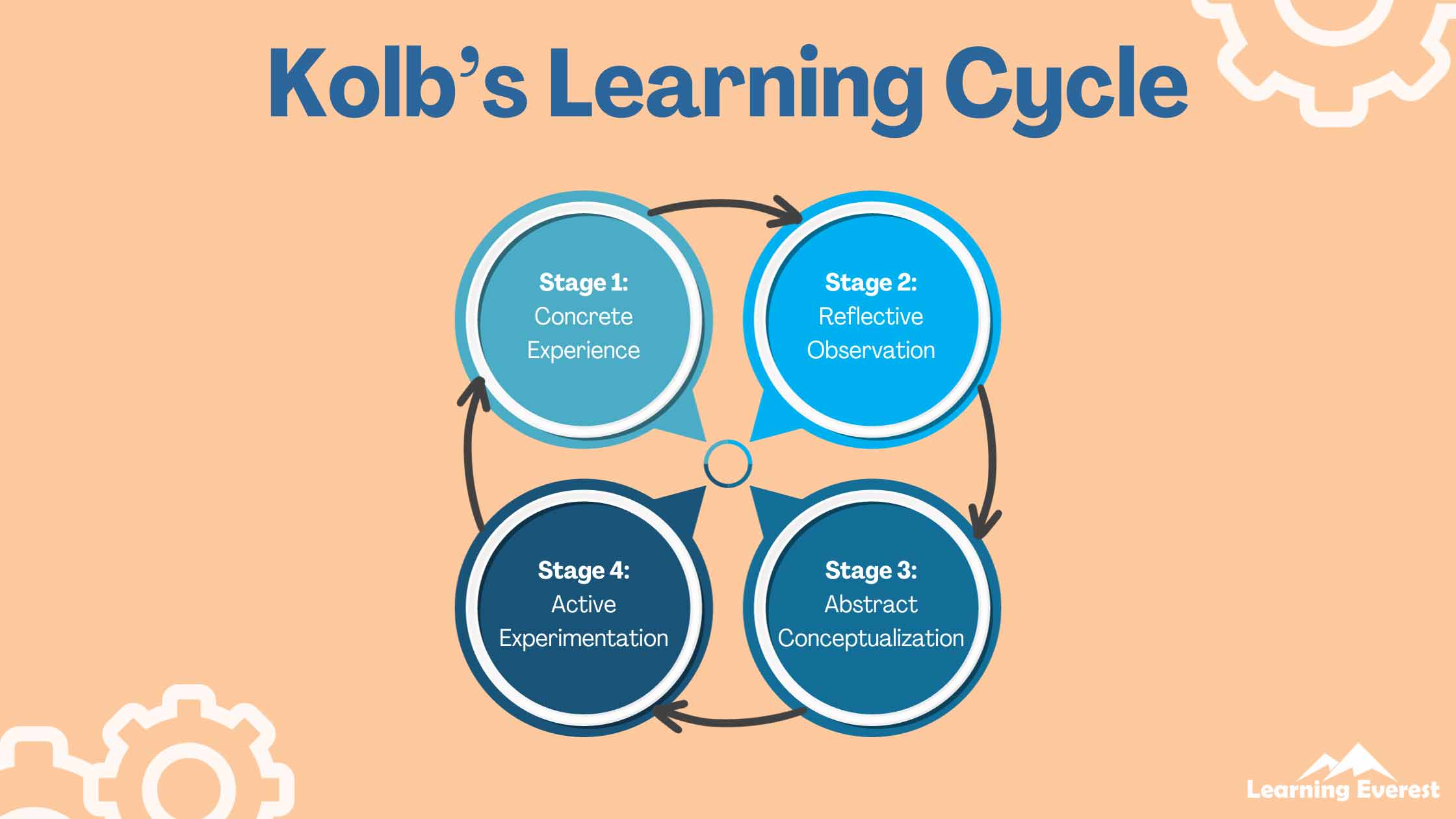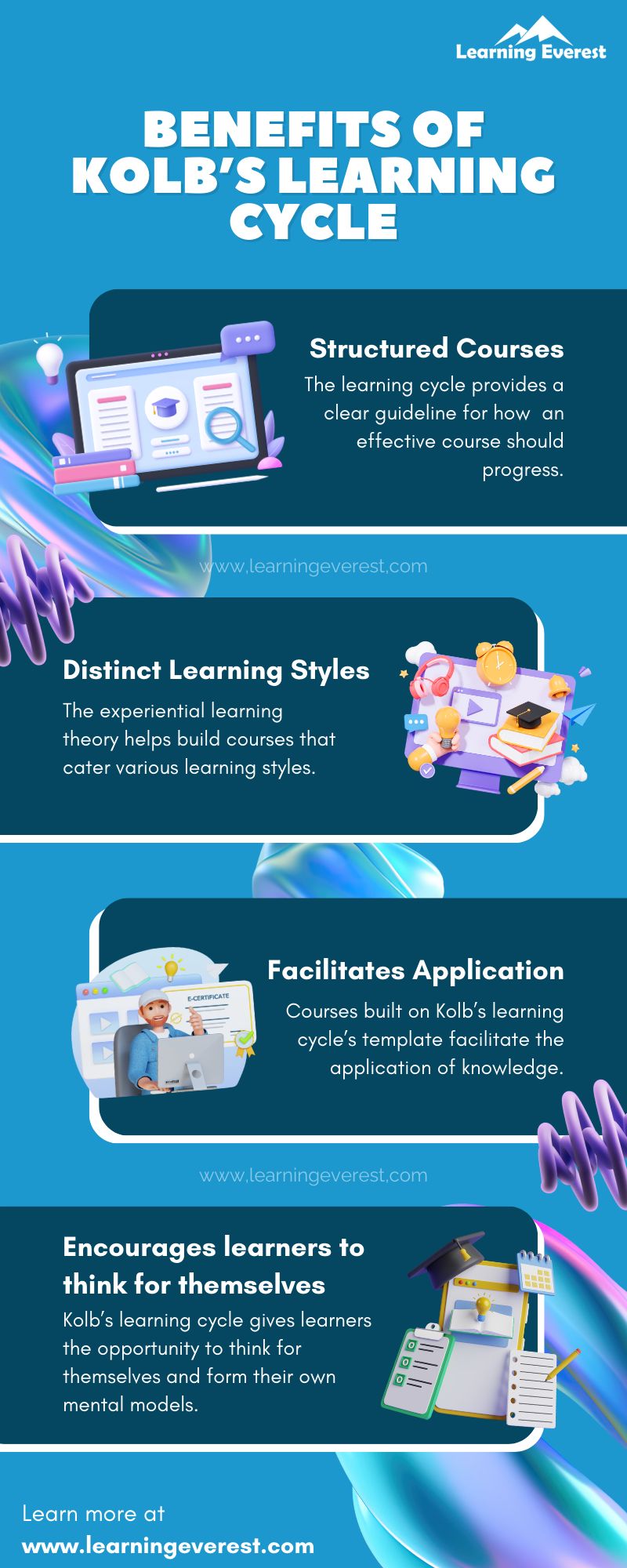Kolb’s learning cycle is a part of his two-level experiential learning theory. Kolb’s theory mainly involves the internal cognitive processes that take place as a learner attempts to make sense of new information. This article will take a look at Kolb’s learning cycle, as well as the learning styles he has proposed in his experiential learning theory. The article will also explore how Kolb’s learning cycle and learning theories can be applied to eLearning environments.
Table of Contents
- What is Kolb’s Learning Cycle?
- Kolb’s Learning Theory
- Applying Kolb’s Learning Cycle and Learning Styles to eLearning
- Conclusion
- Infographic
- Knowledge Check!
- Frequently Asked Questions (FAQs)
- What are the 4 stages of Kolb’s learning cycle?
- What are the 4 learning styles of Kolb?
- How do you apply Kolb’s learning cycle in the eLearning process?
What is Kolb’s Learning Cycle?
Kolb’s learning cycle, also known as the experiential learning cycle, is a four-stage model of how learners interact with and process new information or insights. Learning is most effective when learners go through all 4 stages in Kolb’s learning cycle.

Kolb’s Learning Cycle
Stage 1: Concrete Experience (CE)
In this stage, learners encounter a new experience, for instance, beginning a new training module. The experience could also be a new perspective on something the learner had previously conceptualized. During the concrete experience stage, the learner is open-minded, adaptive, and personally involved with those around them. They simply experience the new situation without attempting to make any meaning out of it just yet.
The concrete experience stage sets the foundation for subsequent stages to gear into action.
Stage 2: Reflective Observation (RO) of the New Experience
In this stage, the learner views the new information in the context of what they already know in an attempt to understand it from various points of view. The learner also checks for any inconsistencies in what they experienced and their existing knowledge.
While the first stage is characterized by open-mindedness, the second stage is characterized by objectivity and rationality. The learner tries to form an opinion about the concrete experience in this stage.
Stage 3: Abstract Conceptualization (AC)
In abstract conceptualization, the learner comes up with new ideas about their experience and observations. They use theories, models, logic, etc. to conceive and refine these ideas. These ideas are typically meant to solve practical issues that the learner faces.
Stage 4: Active Experimentation (AE)
After generating new ideas in the abstract conceptualization stage, the learners start testing them in the real world. They experiment around with their ideas by applying them to different situations.
Once a learner goes through all 4 stages of Kolb’s learning cycle, they form complex mental models about the information and knowledge they have acquired.
In Kolb’s learning cycle, learning is ideally a well-integrated process where all 4 stages are carried out. However, learners can enter the cycle at any stage.
Kolb’s Learning Theory
In the experiential learning theory, Kolb has also given 4 learning styles based on his four-stage learning cycle.
Kolb believes that each individual has a preference when it comes to how they learn and the processes they gravitate to in the learning cycle. These preferences can be shaped by multiple factors, such as genetics, education, environment, etc.
Kolb’s learning styles are often presented in a matrix, as each learning style is a combination of 2 stages from the learning cycle.
| Active Experimentation (Doing) | Reflective Observation (Watching) | |
|---|---|---|
| Concrete Experience (Feeling) | Accommodating (CE/AE) | Diverging (CE/RO) |
| Abstract Conceptualization (Thinking) | Converging (AC/AE) | Assimilating (AC/RO) |
It is worth noting that while learners do have preferences in their learning styles, learning interventions should be diverse in the kind of stimulus they provide to learners.
Let us now look at each learning style in detail and see which stages of Kolb’s learning cycle they correspond to.
Accommodating Learning Style (CE/AE)
The accommodating learning style’s main modes are feeling and doing. People who use this learning style are hands-on and intuitive. They use concrete experience to observe other peoples’ methods and analyses. They then try out what they have observed with active experimentation on their own, taking a practical and experiential approach to learning. They often use their “gut” instincts to decide which observed information they want to try their hands at. Accommodating learners prefer using their intuition and instincts over logical reasoning.
Diverging Learning Style (CE/RO)
People with the diverging learning style use feeling and watching. The stages they gravitate to from Kolb’s learning cycle are concrete experience and reflective observation.
These learners like to keep an open mind while learning and prefer working with ideas over hands on activities.
Diverging learners watch others and gather information, which they then use to brainstorm and generate ideas. Diverging learners are imaginative and creative and can come up with innovative ways to solve problems and create things. They also take a more emotional and feeling-based approach to learning rather than a logic and rationality-based approach, according to Kolb.
Diverging learners can thrive in group settings and creative environments such as applied arts. They also appreciate feedback.
Converging Learning Style (AC/AE)
Converging learners use a mixture of abstract conceptualization and active experimentation from Kolb’s learning cycle. They learn primarily by doing and thinking.
Converging learners prefer working on technical information and tasks. Their strength is to come up with practical solutions to problems using the theories, models, and concepts they have gathered and cultivated using abstract conceptualization.
Converging learners aren’t fond of learning with and through others as they use thinking and doing as their main learning functions. Instead, they like gathering logical information and applying this information in various contexts.
Hence, they like practicals, simulations, and well-developed ideas that have practical value.
Assimilating Learning Style (AC/RO)
This learning style consists of the learner thinking and watching. Learners with this learning style mainly use abstract conceptualization and reflective observation from Kolb’s learning cycle.
These learners are analytical, and capable of organizing information into logical formats and frameworks. When it comes to information, they prefer logical consistency over practical value.
As learners, they value well-organized and clearly explained information and tend to be a good fit for information and science-related fields and careers.
Applying Kolb’s Learning Cycle and Learning Styles to eLearning
In the experiential learning theory, Kolb’s learning cycle and learning styles work together to create effective learning experiences. The general gist of the theory is that humans learn by making personal sense out of their experiences and testing their conclusions in the real world. However, the theory also acknowledges that despite effective learning being a product of going through the entire learning cycle, learners have their preferences.
Here are some ways you can incorporate elements from Kolb’s learning cycle and learning styles in your eLearning courses:
- Use social learning elements like group discussions, demos, message boards, peer-graded assessments, and user-generated content to create new experiences for learners.
- You can also facilitate new experiences through rich videos with strong narratives.
- Present your learners with thought-provoking questions, assignments, and quizzes to exercise their reflective observation. Try to build courses in a way that enables and encourages learners to think about their interpretation and feelings about the course content.
- Abstract conceptualization can be facilitated by presenting content in a logical sequence, strong and clear technical writing, embedded media and links (e.g., eBooks, podcasts, lectures, etc.), flowcharts and tables, and a wealth of references. Learners can also be given analysis-focused assignments, debate projects, compare and contrast prompts, etc.
- Active experimentation can be facilitated using scenario-based learning, gamification, and simulated learning environments where learners have some freedom over their choices.
Conclusion
Kolb’s learning cycle and the experiential theory as a whole can be used to enrich eLearning experiences to make them more compelling and impactful for learners.
Infographic

Benefits of Kolb’s Learning Cycle and Learning Styles
Knowledge Check!
Frequently Asked Questions (FAQs)
What are the 4 stages of Kolb’s learning cycle?
The 4 stages of Kolb’s learning cycle are Concrete Experience, Reflective Observation, Abstract Conceptualization, and Active Experimentation.
What are the 4 learning styles of Kolb?
The 4 learning styles given by Kolb are accommodating, diverging, converging, and assimilating.
How do you apply Kolb’s learning cycle in the eLearning process?
Kolb’s learning cycle can be applied to the eLearning process by giving eLearning content a strong start, incorporating social learning elements, providing activities where learners have to explore and think on their own, and giving learners high-quality content that is well organized, meaningful, and easy to digest.





